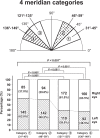Prevalence and characteristics of oblique astigmatism
- PMID: 36928225
- PMCID: PMC10564798
- DOI: 10.1038/s41433-023-02470-7
Prevalence and characteristics of oblique astigmatism
Abstract
Objective: To examine the incidence and characteristics of eyes with oblique astigmatism stratified by meridian, age, sex, and eye side (left to right).
Methods: One thousand eyes of 1000 patients with oblique corneal astigmatism underwent videokeratographic examination and was classified into 4 meridian categories: (1) 31°-45°, (2) 46°-59°, (3) 121°-135°, and (4) 136°-149°. Amounts of regular and irregular astigmatism, and the vertical/horizontal (Rx) and oblique astigmatism components (Ry) decomposed using vector analysis were compared among the 4 categories and age groups, and between sexes and eye sides.
Results: Incidences of the 4 meridian categories were similar and did not differ significantly among age groups or between sexes. The incidence was significantly greater in eyes in meridian categories 1 and 2 in the left eye and categories 3 and 4 in the right eye, and significantly greater in men in their 40 s and 50 s and in women in their 70 s and 80 s (P < 0.0001). The mean regular astigmatism, asymmetry and higher-order irregularity components, and Rx and absolute Ry significantly increased with age (P ≤ 0.0372). The mean regular and irregular astigmatism, and absolute Rx and Ry did not differ significantly among the 4 categories, or between sexes or left and right eyes.
Conclusions: The incidence of oblique astigmatism was significantly greater in the temporal side meridians, and the incidence in women increased with age. The degree of oblique astigmatism increased with age, with an increase in irregular astigmatism.
© 2023. The Author(s), under exclusive licence to The Royal College of Ophthalmologists.
Conflict of interest statement
The authors declare no competing interests.
Figures





References
-
- Næser K. Assessment and statistics of surgically induced astigmatism. Acta Ophthalmol. 2008;86(Suppl 1):5–28. - PubMed
MeSH terms
LinkOut - more resources
Full Text Sources
Medical

